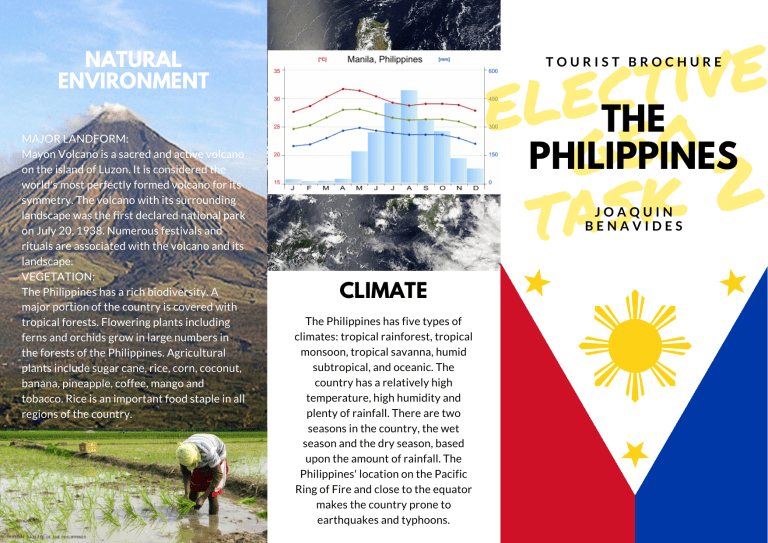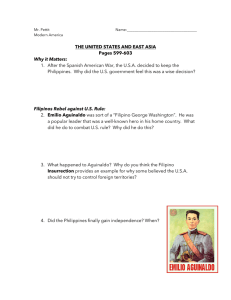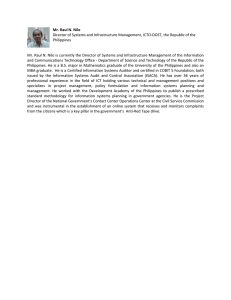
e v i t c e el THEo PHILIPPINES ge 2 k s a t NATURAL ENVIRONMENT MAJOR LANDFORM: Mayon Volcano is a sacred and active volcano on the island of Luzon. It is considered the world's most perfectly formed volcano for its symmetry. The volcano with its surrounding landscape was the first declared national park on July 20, 1938. Numerous festivals and rituals are associated with the volcano and its landscape. VEGETATION: The Philippines has a rich biodiversity. A major portion of the country is covered with tropical forests. Flowering plants including ferns and orchids grow in large numbers in the forests of the Philippines. Agricultural plants include sugar cane, rice, corn, coconut, banana, pineapple, coffee, mango and tobacco. Rice is an important food staple in all regions of the country. TOURIST BROCHURE JOAQUIN BENAVIDES CLIMATE The Philippines has five types of climates: tropical rainforest, tropical monsoon, tropical savanna, humid subtropical, and oceanic. The country has a relatively high temperature, high humidity and plenty of rainfall. There are two seasons in the country, the wet season and the dry season, based upon the amount of rainfall. The Philippines' location on the Pacific Ring of Fire and close to the equator makes the country prone to earthquakes and typhoons. e l p Peo CULTURE: The culture of the Philippines is a combination of the East and West. Filipino identity was developed as a result of pre-colonial cultures, colonial influences and foreign traders intermixing together; gradually evolving into a unique culture. ETHNICITY: Filipinos come from various ethnolinguistic groups that are native to the islands or migrants from various Asia-Pacific regions. Filipinos have Austronesian roots, and their ethnicity is mainly influenced by China, the United States, and Spain. PREDOMINANT CULTURAL GROUPS: The Philippines is inhabited by more than 175 ethnolinguistic nations, which include the Ivatan, Pangasinan, Kapampangan, Tagalog, Bicolano, Visayans, Zamboangueño and Subanon. The Negrito migrated from Africa and were among the earliest human beings to settle in the Philippines. Their tribal groups include the Ati and the Aeta. A majority of the Filipinos are related to Malay people. RELIGIONS: The Philippines is one of the few majority Christian nations in Asia. More than 92 percent of the population is Christian(mainly Roman Catholic), an approximate 4 percent are Muslim, around 2 percent follow indigenous beliefs and a statistically insignificant minority includes the beliefs of Buddhism, Taoism, and Confucianism. MAJOR FESTIVAL: The Ati-Atihan Festival is a feast held annually on the third Sunday of January in honour of the Santo Niño (Infant Jesus). The name AtiAtihan means to be like Atis, the local name for the Aeta aborigines. The festival consists of tribal dance, music, accompanied by indigenous costumes and weapons. FOOD Filipino cuisine has a mix of Malaysian, Indonesian, Indian, Chinese, Spanish and American influences adapted to indigenous ingredients and the local palate. Popular dishes include lechón(whole roasted pig), adobo (chicken or pork braised in garlic, vinegar, oil and soy sauce, or cooked until dry) and sinigang (meat or seafood in sour broth). It is noted that Filipino cuisine is a multi-faceted representation of a mix of eastern and western food influences. ACCOMMODATION The Philippines has a range of accommodation for both long and short term stays in the country. This includes hotels, bed and breakfasts, guesthouses, hostels and motels. TRANSPORT Transportation is relatively underdeveloped due to the country's lack of investment in infrastructure. Jeepneys are the most popular mode of public transportation and are a symbol ubiquitous with filipino culture. Another popular mode of public transportation is the motorised tricycle, more common in rural areas. Improvement in transportation systems has led to increased train usage.







